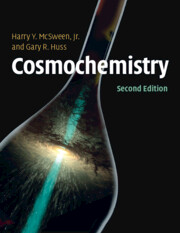Refine listing
Actions for selected content:
16950 results
Appendix: Some Analytical Techniques Commonly Used in Cosmochemistry
-
- Book:
- Cosmochemistry
- Published online:
- 10 February 2022
- Print publication:
- 03 March 2022, pp 400-418
-
- Chapter
- Export citation
3 - Origin of the Elements
-
- Book:
- Cosmochemistry
- Published online:
- 10 February 2022
- Print publication:
- 03 March 2022, pp 37-59
-
- Chapter
- Export citation
4 - Solar System and Cosmic Abundances
-
- Book:
- Cosmochemistry
- Published online:
- 10 February 2022
- Print publication:
- 03 March 2022, pp 60-84
-
- Chapter
- Export citation
2 - Nuclides and Elements
-
- Book:
- Cosmochemistry
- Published online:
- 10 February 2022
- Print publication:
- 03 March 2022, pp 20-36
-
- Chapter
- Export citation
Dedication
-
- Book:
- Cosmochemistry
- Published online:
- 10 February 2022
- Print publication:
- 03 March 2022, pp v-vi
-
- Chapter
- Export citation

Cosmochemistry
-
- Published online:
- 10 February 2022
- Print publication:
- 03 March 2022
An Overview of General Relativity
-
- Book:
- A Student's Guide to Special Relativity
- Published online:
- 26 January 2022
- Print publication:
- 03 February 2022, pp 145-176
-
- Chapter
- Export citation
2 - The Axioms
-
- Book:
- A Student's Guide to Special Relativity
- Published online:
- 26 January 2022
- Print publication:
- 03 February 2022, pp 18-31
-
- Chapter
- Export citation
4 - Spacetime and Geometry
-
- Book:
- A Student's Guide to Special Relativity
- Published online:
- 26 January 2022
- Print publication:
- 03 February 2022, pp 45-71
-
- Chapter
- Export citation
Appendix B - Relativity’s Contact with Experimental Fact
-
- Book:
- A Student's Guide to Special Relativity
- Published online:
- 26 January 2022
- Print publication:
- 03 February 2022, pp 177-193
-
- Chapter
- Export citation
3 - Length Contraction and Time Dilation
-
- Book:
- A Student's Guide to Special Relativity
- Published online:
- 26 January 2022
- Print publication:
- 03 February 2022, pp 32-44
-
- Chapter
- Export citation
Copyright page
-
- Book:
- A Student's Guide to Special Relativity
- Published online:
- 26 January 2022
- Print publication:
- 03 February 2022, pp iv-iv
-
- Chapter
- Export citation
Contents
-
- Book:
- A Student's Guide to Special Relativity
- Published online:
- 26 January 2022
- Print publication:
- 03 February 2022, pp vii-x
-
- Chapter
- Export citation
Aims
-
- Book:
- A Student's Guide to Special Relativity
- Published online:
- 26 January 2022
- Print publication:
- 03 February 2022, pp xvi-xvi
-
- Chapter
- Export citation
Acknowledgements
-
- Book:
- A Student's Guide to Special Relativity
- Published online:
- 26 January 2022
- Print publication:
- 03 February 2022, pp xv-xv
-
- Chapter
- Export citation
Preface
-
- Book:
- A Student's Guide to Special Relativity
- Published online:
- 26 January 2022
- Print publication:
- 03 February 2022, pp xi-xiv
-
- Chapter
- Export citation
References
-
- Book:
- A Student's Guide to Special Relativity
- Published online:
- 26 January 2022
- Print publication:
- 03 February 2022, pp 205-210
-
- Chapter
- Export citation
Preface
-
- Book:
- A Student's Guide to Special Relativity
- Published online:
- 26 January 2022
- Print publication:
- 03 February 2022, pp xi-xiv
-
- Chapter
- Export citation
7 - Dynamics
-
- Book:
- A Student's Guide to Special Relativity
- Published online:
- 26 January 2022
- Print publication:
- 03 February 2022, pp 125-144
-
- Chapter
- Export citation
Contents
-
- Book:
- A Student's Guide to Special Relativity
- Published online:
- 26 January 2022
- Print publication:
- 03 February 2022, pp vii-x
-
- Chapter
- Export citation
